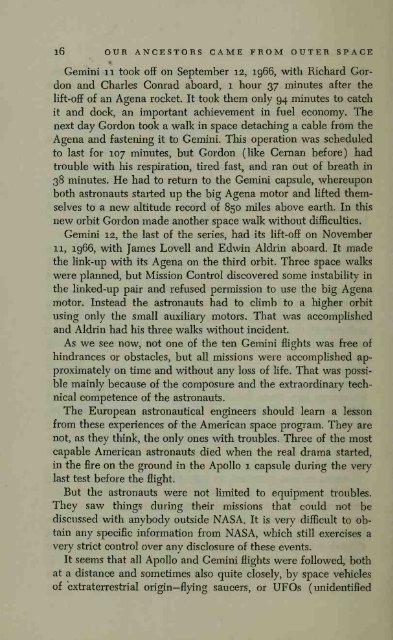Create successful ePaper yourself
Turn your PDF publications into a flip-book with our unique Google optimized e-Paper software.
l6<br />
OUR ANCESTORS CAME FROM OUTER SPACE<br />
Gemini ii took ofiF on September 12, 1966, with Richard Gordon<br />
and Charles Conrad aboard, 1 hour 37 minutes after the<br />
HiFt-oflF of an Agena rocket. It took them only 94 minutes to catch<br />
it and dock, an important achievement in fuel economy. The<br />
next day Gordon took a walk in space detaching a cable from the<br />
Agena and fastening it to Gemini. This operation was scheduled<br />
to last for 107 minutes, but Gordon (like Cernan before) had<br />
trouble with his respiration, tired fast, and ran out of breath in<br />
38 minutes. He had to return to the Gemini capsule, whereupon<br />
both astronauts started up the big Agena motor and lifted themselves<br />
to a new altitude record of 850 miles above earth. In this<br />
new orbit Gordon made another space walk without difficulties.<br />
Gemini 12, the last of the series, had its lift-off on November<br />
11, 1966, with James Lovell and Edwin Aldrin aboard. It made<br />
the link-up with its Agena on the third orbit. Three space walks<br />
were planned, but Mission Control discovered some instability in<br />
the linked-up pair and refused permission to use the big Agena<br />
motor. Instead the astronauts had to cHmb to a higher orbit<br />
using only the small auxiliary motors. That was accomplished<br />
and Aldrin had his three walks without incident.<br />
As we see now, not one of the ten Gemini flights was free of<br />
hindrances or obstacles, but all missions were accomplished approximately<br />
on time and without any loss of life. That was possible<br />
mainly because of the composure and the extraordinary technical<br />
competence of the astronauts.<br />
The European astronautical engineers should learn a lesson<br />
from these experiences of the American space program. They are<br />
not, as they think, the only ones with troubles. Three of the most<br />
capable American astronauts died when the real drama started,<br />
in the fire on the ground in the Apollo 1 capsule during the very<br />
last test before the flight.<br />
But the astronauts were not limited to equipment troubles.<br />
They saw tilings during their missions that could not be<br />
discussed with anybody outside NASA. It is very difficult to obtain<br />
any specific information from NASA, which still exercises a<br />
very strict control over any disclosure of these events.<br />
It seems that all Apollo and Gemini flights were followed, both<br />
at a distance and sometimes also quite closely, by space vehicles<br />
of extraterrestrial origin—flying saucers, or UFOs (unidentified

















